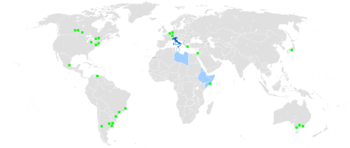Italian language
| Italian | |
|---|---|
| Italiano, Lingua italiana | |
| Pronunciation | [itaˈljaːno] |
| Native to | Italy, Switzerland, San Marino, Vatican City, Slovenia (Slovenian Istria), Croatia (Istria County) and the Italian diaspora |
| Region | (widely known among older and educated people and in the commercial sectors of Somalia, Eritrea and Libya; used in the Federal Government of Somalia) |
Native speakers |
64 million, native and native bilingual (2012)[1] (note: figure for France is dated) |
|
Latin (Italian alphabet) Italian Braille | |
|
Italiano segnato "Signed Italian"[2] italiano segnato esatto "Signed Exact Italian"[3] | |
| Official status | |
Official language in |
|
Recognised minority language in | |
| Regulated by | Accademia della Crusca (de facto) |
| Language codes | |
| ISO 639-1 |
it |
| ISO 639-2 |
ita |
| ISO 639-3 |
ita |
| Glottolog |
ital1282[4] |
| Linguasphere |
51-AAA-q |
|
The geographic distribution of the Italian language in the world: large Italian-speaking communities are shown in green; light blue indicates areas where the Italian language was used officially during the Italian colonial period. | |
| Part of a series on the |
| Italian language |
|---|
|
| History |
| Literature and other |
| Grammar |
| Alphabet |
| Phonology |
Italian (![]() italiano or lingua italiana) is a Romance language spoken mainly in Europe: Italy, Switzerland, San Marino, Vatican City, as a second language in Malta, Slovenia and Croatia, by minorities in Albania, Crimea, Eritrea, France, Libya, Monaco, Montenegro, Romania and Somalia,[5] and by expatriate communities in Europe, in the Americas and in Australia. Many speakers are native bilinguals of both standardised Italian and other regional languages.[6]
italiano or lingua italiana) is a Romance language spoken mainly in Europe: Italy, Switzerland, San Marino, Vatican City, as a second language in Malta, Slovenia and Croatia, by minorities in Albania, Crimea, Eritrea, France, Libya, Monaco, Montenegro, Romania and Somalia,[5] and by expatriate communities in Europe, in the Americas and in Australia. Many speakers are native bilinguals of both standardised Italian and other regional languages.[6]
According to the Bologna statistics of the European Union, Italian is spoken as a native language by 59 million people in the EU (13% of the EU population), mainly in Italy, and as a second language by 14 million (3%).[7] Including the Italian speakers in non-EU European countries (such as Switzerland and Albania) and on other continents, the total number of speakers is around 85 million.[8]
In Switzerland, Italian is one of three official languages (Romansh is a national language but not an official one nationwide[9]); it is studied and learned in all the confederation schools and spoken, as a native language, in the Swiss cantons of Ticino and Graubünden (predominately in Italian Grigioni) and by the Italian immigrants that are present in large numbers in German- and French-speaking cantons. It is also the official language of San Marino, as well as the primary language of the Vatican City.[10] It is co-official in Slovenian Istria and in Istria County in Croatia. The Italian language adopted by the state after the unification of Italy is based on Tuscan, which beforehand was a language spoken mostly by the upper class of Florentine society.[11] Its development was also influenced by other Italian languages and by the Germanic languages of the post-Roman invaders.
Italian is descended from Latin. Unlike most other Romance languages, Italian retains Latin's contrast between short and long consonants. As in most Romance languages, stress is distinctive. Among the Romance languages, Italian is the closest to Latin in terms of vocabulary.[12]
History
Origins
The standard Italian language has a poetic and literary origin in the twelfth century, and the modern standard of the language was largely shaped by relatively recent events. However, Italian as a language used in the Italian Peninsula has a longer history. In fact the earliest surviving texts that can definitely be called Italian (or more accurately, vernacular, as distinct from its predecessor Vulgar Latin) are legal formulae known as the Placiti Cassinesi from the Province of Benevento that date from 960–963, although the Veronese Riddle contains a late form of Vulgar Latin that can be seen as a very early Italian dialect.[13] What would come to be thought of as Italian was first formalized in the early fourteenth century through the works of Tuscan writer Dante Alighieri, written in his native Florentine. Dante's epic poems, known collectively as the Commedia, to which another Tuscan poet Giovanni Boccaccio later affixed the title Divina, were read throughout Italy and his written dialect became the "canonical standard" that all educated Italians could understand. Dante is still credited with standardizing the Italian language, and thus the dialect of Florence became the basis for what would become the official language of Italy.
Italian often was an official language of the various Italian states predating unification, slowly usurping Latin, even when ruled by foreign powers (such as the Spanish in the Kingdom of Naples, or the Austrians in the Kingdom of Lombardy-Venetia), even though the masses spoke primarily vernacular languages and dialects. Italian was also one of the many recognised languages in the Austro-Hungarian Empire.
Italy has always had a distinctive dialect for each city, because the cities, until recently, were thought of as city-states. Those dialects now have considerable variety. As Tuscan-derived Italian came to be used throughout Italy, features of local speech were naturally adopted, producing various versions of Regional Italian. The most characteristic differences, for instance, between Roman Italian and Milanese Italian are the gemination of initial consonants and the pronunciation of stressed "e", and of "s" in some cases: e.g. va bene "all right": is pronounced [va ˈbːɛne] by a Roman (and by any standard-speaker), [va ˈbene] by a Milanese (and by any speaker whose native dialect lies to the north of La Spezia–Rimini Line); a casa "at home" is [a ˈkːasa] for Roman and standard, [a ˈkaza] for Milanese and generally northern.
In contrast to the Northern Italian language, southern Italian dialects and languages were largely untouched by the Franco-Occitan influences introduced to Italy, mainly by bards from France, during the Middle Ages but, after the Norman conquest of southern Italy, Sicily became the first Italian land to adopt Occitan lyric moods (and words) in poetry. Even in the case of Northern Italian language, however, scholars are careful not to overstate the effects of outsiders on the natural indigenous developments of the languages.
The economic might and relatively advanced development of Tuscany at the time (Late Middle Ages) gave its dialect weight, though the Venetian language remained widespread in medieval Italian commercial life, and Ligurian (or Genoese) remained in use in maritime trade alongside the Mediterranean. The increasing political and cultural relevance of Florence during the periods of the rise of the Banco Medici, Humanism, and the Renaissance made its dialect, or rather a refined version of it, a standard in the arts.
Renaissance
Starting with the Renaissance, Italian became the language used in the courts of every state in the peninsula. The rediscovery of Dante's De vulgari eloquentia and a renewed interest in linguistics in the sixteenth century, sparked a debate that raged throughout Italy concerning the criteria that should govern the establishment of a modern Italian literary and spoken language. Scholars divided into three factions:
- The purists, headed by Venetian Pietro Bembo (who, in his Gli Asolani, claimed the language might be based only on the great literary classics, such as Petrarch and some part of Boccaccio). The purists thought the Divine Comedy not dignified enough, because it used elements from non-lyric registers of the language.
- Niccolò Machiavelli and other Florentines preferred the version spoken by ordinary people in their own times.
- The courtiers, like Baldassare Castiglione and Gian Giorgio Trissino, insisted that each local vernacular contribute to the new standard.
A fourth faction claimed the best Italian was the one that the papal court adopted, which was a mix of Florentine and the dialect of Rome. Eventually, Bembo's ideas prevailed, and the foundation of the Accademia della Crusca in Florence (1582–1583), the official legislative body of the Italian language led to publication of Agnolo Monosini's Latin tome Floris italicae linguae libri novem in 1604 followed by the first Italian dictionary in 1612.
Modern era
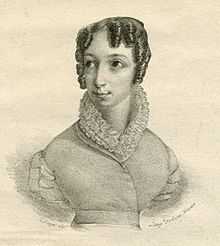
An important event that helped the diffusion of Italian was the conquest and occupation of Italy by Napoleon in the early nineteenth century (who was himself of Italian-Corsican descent). This conquest propelled the unification of Italy some decades after, and pushed the Italian language into a lingua franca used not only among clerks, nobility and functionaries in the Italian courts but also in the bourgeoisie.
Contemporary times
Italian literature's first modern novel, I Promessi Sposi (The Betrothed), by Alessandro Manzoni, further defined the standard by "rinsing" his Milanese "in the waters of the Arno" (Florence's river), as he states in the Preface to his 1840 edition.
After unification a huge number of civil servants and soldiers recruited from all over the country introduced many more words and idioms from their home languages ("ciao" is derived from Venetian word "s-cia[v]o" (slave), "panettone" comes from Lombard word "panetton" etc.). Only 2.5% of Italy's population could speak the Italian standardized language properly when the nation unified in 1861, centered mainly in northwestern Italy.[14]
Classification
Italian is a Romance language, and is therefore a descendant of Vulgar Latin. Standard Italian is based on Tuscan, especially its Florentine dialect, and is therefore an Italo-Dalmatian language, to which Sicilian and the extinct Dalmatian also belong, among a few others.
Unlike most other Romance languages, Italian retains Latin's contrast between short and long consonants. As in most Romance languages, stress is distinctive. In particular, among the Romance languages, Italian is the closest to Latin in terms of vocabulary.[12] Lexical similarity is 89% with French, 88% with Catalan, 85% with Sardinian, 82% with Spanish and Portuguese, 78% with Rhaeto-Romance, and 77% with Romanian.[5][15]
Geographic distribution
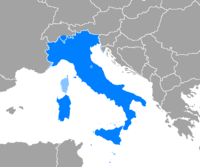
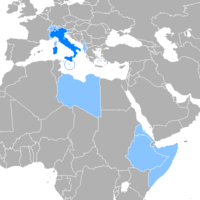
Europe
Italian is the official language of Italy and San Marino and is spoken fluently by the majority of the countries' populations. Italian is official, together with French, German and Romansch in Switzerland, with most of the 0.5 million speakers concentrated in the south of the country, in the cantons of Ticino and southern Graubünden (predominately in Italian Grigioni). Italian is the third most spoken language in Switzerland (after German and French), and its use has modestly declined since the 1970s.[16] Italian is also used in administration and official documents in Vatican City.[17]
Italian is widely spoken in Malta, where nearly two-thirds of the population can speak it fluently.[18] Italian served as Malta's official language until 1934, while it is also recognized as an official language in Istria County, Croatia and Slovenian Istria, where there are significant and historic Italian populations.
It is used as the official language of the Sovereign Military Order of Malta, a Roman Catholic chivalric order which, while not a nation per se, is still recognized as a sovereign subject of international law.
Italian is also spoken by a minority in Monaco and France (especially in the southeast of the country and Corsica).[19][20] Small Italian-speaking minorities can also be found in Albania and Montenegro.
Africa
Due to heavy Italian influence during the Italian colonial period, Italian is still understood by some in Libya and Eritrea.[5] Although it was the primary language since colonial rule, Italian greatly declined under the rule of Muammar Gaddafi, who expelled the Italian Libyan population and made Arabic the sole official language of the country.[21] Nevertheless, Italian is sometimes used in economic sectors in Libya. In Eritrea, Italian is at times used in commerce and the capital city Asmara still has one Italian-language school.[22] Italian was also introduced to Somalia through colonialism and was the sole official language of administration and education during the colonial period but fell out of use after government, educational and economic infrastructure were destroyed in the Somali Civil War. Italian is still understood by some elderly and the educated people.The official languages of the Somali Republic are Somali (Maay and Maxaatiri) and Arabic. The second languages of the Transitional Federal Government are English.[23]
Immigrant communities
Although over 17 million Americans are of Italian descent, only a little over one million people in the United States speak Italian at home.[24] Nevertheless, an Italian language media market does exist in the country.[25]
In Canada, Italian is the second most spoken non-official language when Chinese languages are not combined, with over 660,000 speakers (or about 2.1% of the population) according to the 2006 Census.[26]
In Australia, Italian is the second most spoken foreign language after the Chinese languages, with 1.4% of the population speaking it as their home language.[27]
Italian immigrants to South America have also brought a presence of the language to the continent. Italian is the second most spoken language in Argentina after the official language of Spanish, with 1.5 million speaking it natively, and Italian has also influenced the dialect of Spanish spoken in Argentina and Uruguay, Rioplatense Spanish.[5] Small Italian-speaking minorities on the continent are also found in Uruguay, Ecuador, Venezuela and Brazil.
Education
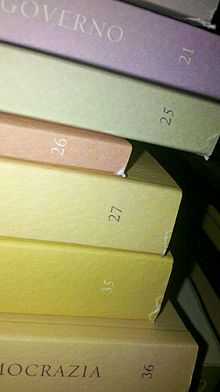
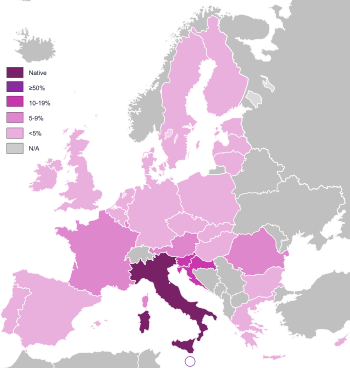
Italian is widely taught in many schools around the world, but rarely as the first foreign language; in fact, Italian is considered the fourth[28] most frequently taught foreign language in the world.[29]
According to the Italian Ministry of Foreign Affairs, every year there are more than 200,000 foreign students who study the Italian language; they are distributed among the 90 Institutes of Italian Culture that are located around the world, or in the 179 Italian schools located abroad, or in the 111 Italian lecturer sections belonging to foreign schools where Italian is taught as a language of culture.[30]
In the United States, Italian is the fourth most taught foreign language after Spanish, French and German, in that order (or the fifth if American Sign Language is considered).[31] In central-east Europe Italian is first in Montenegro, second in Austria, Croatia, Slovenia, and Ukraine after English, and third in Hungary, Romania and Russia after English and German.[30] But throughout the world, Italian is the fifth most taught foreign language, after English, French, German, and Spanish.[32]
In the European Union statistics, Italian is spoken as a native language by 13% of the EU population, or 65 million people,[7] mainly in Italy. In the EU, it is spoken as a second language by 3% of the EU population, or 14 million people. Among EU states, the percentage of people able to speak Italian well enough to have a conversation is 66% in Malta, 15% in Slovenia, 14% in Croatia, 8% in Austria, 5% in France and Luxembourg, and 4% in the former West Germany, Greece, Cyprus, and Romania.[33] Italian is also one of the national languages of Switzerland, which is not a part of the European Union.[34] The Italian language is well-known and studied in Albania,[35] another non-EU member, due to its historical ties and geographical proximity to Italy and to the diffusion of Italian television in the country.[36]
Influence and derived languages
From the late nineteenth to the mid-twentieth century, thousands of Italians settled in Argentina, Uruguay, southern Brazil, and Venezuela, where they formed a physical and cultural presence.
In some cases, colonies were established where variants of regional languages of Italy were used, and some continue to use this regional language. Examples are Rio Grande do Sul, Brazil, where Talian is used, and the town of Chipilo near Puebla, Mexico; each continues to use a derived form of Venetian dating back to the nineteenth century. Another example is Cocoliche, an Italian–Spanish pidgin once spoken in Argentina and especially in Buenos Aires, and Lunfardo.
Rioplatense Spanish, and particularly the speech of the city of Buenos Aires, has intonation patterns that resemble those of Italian languages, because Argentina has had a continuous large influx of Italian settlers since the second half of the nineteenth century: initially primarily from northern Italy; then, since the beginning of the twentieth century, mostly from southern Italy.
Lingua franca
Starting in late medieval times in much of Europe and the Mediterranean, Latin was replaced as the primary commercial language by Italian language variants (especially Tuscan and Venetian). These variants were consolidated during the Renaissance with the strength of Italy and the rise of humanism and the arts.
During that period, Italy held artistic sway over the rest of Europe. It was the norm for all educated gentlemen to make the Grand Tour, visiting Italy to see its great historical monuments and works of art. It thus became expected to learn at least some Italian. In England, while the classical languages Latin and Greek were the first to be learned, Italian became the second most common modern language after French, a position it held until the late eighteenth century, when it tended to be replaced by German. John Milton, for instance, wrote some of his early poetry in Italian.
Within the Catholic church, Italian is known by a large part of the ecclesiastical hierarchy, and is used in substitution for Latin in some official documents. The primacy of Italian as a language in the Vatican City indicates use, not only within the Holy See, but throughout the world wherever an episcopal seat is present.
Italian loanwords continue to be used in most languages in matters of art and music (especially opera), in the design and fashion industries, and in some sports (football and motorsports).
Dialects
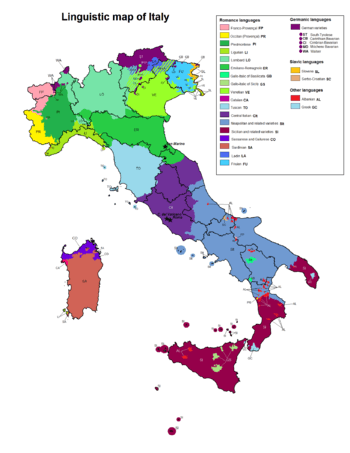
Throughout Italy, regional variations of Standard Italian, called Regional Italian, are spoken. In Italy, almost all Romance languages spoken as the vernacular—other than standard Italian and distantly-related, non-Romance languages spoken in border regions or among immigrant communities—are often imprecisely called "Italian dialects",[37] even though they are quite different, with some belong to different branches of the Romance language family. The only exceptions to this are Sardinian, Ladin, and Friulan, which the law recognises as official regional languages. The Corsican language is also related to Italian.
Regional differences can be recognized by various factors: the openness of vowels, the length of the consonants, and influence of the local language (for example, in informal situations the contraction annà replaces andare in the area of Rome for the infinitive "to go"; and nare is what Venetians say for the infinitive "to go").
Phonology
| Bilabial | Labio- dental |
Dental/ Alveolar |
Post- alveolar |
Palatal | Velar | |||||||
|---|---|---|---|---|---|---|---|---|---|---|---|---|
| Nasal | m | n | ɲː | |||||||||
| Stop | p | b | t | d | k | ɡ | ||||||
| Affricate | t͡s | d͡z | t͡ʃ | d͡ʒ | ||||||||
| Fricative | f | v | s | z | ʃː | |||||||
| Approximant | j | w | ||||||||||
| Lateral | l | ʎː | ||||||||||
| Trill | r | |||||||||||
Notes:
- Between two vowels, or between a vowel and an approximant or liquid (/l r/ or /w j/), consonants can be either single or geminated. Geminated consonants shorten the preceding vowel (or block phonetic lengthening) and the first geminated element is unreleased. For example, /fato/ [ˈfaː.to] ~ /fatto/ [ˈfat.to] (first one means "fate, destiny" and the second means "fact"). However, /ɲ/, /ʃ/, /ʎ/, are always geminated word-internally.[38] Similarly, nasals, liquids, and sibilants are pronounced slightly longer before medial consonant clusters.[39]
- /z/ is the only consonant that cannot be geminated.
- /t d t͡s d͡z s z/ are denti-alveolar, while /l n/ are alveolar.[40][41]
- The trill /r/ is sometimes reduced to a single vibration when not geminated, but it is not a flap *[ɾ].
- Nasals assimilate to the point of articulation of whatever consonant they precede. For example, /nɡ/ is realized as [ŋɡ].
- The distinction between /s/ and /z/ is neutralized before consonants and at the beginning of words: the former is used before voiceless consonants and before vowels at the beginning of words; the latter is used before voiced consonants (meaning [z] is an allophone of /s/ before voiced consonants). The two are only contrasted between two vowels within a word. According to Canepari,[42] though, the traditional standard has been replaced by a modern neutral pronunciation which always prefers /z/ when intervocalic, except when the intervocalic s is the initial sound of a word or a morpheme, if the compound is still felt as such: for example, presento /preˈsɛnto/[43] ('I foresee', with pre meaning 'before' and sento meaning 'I see') vs. presento /preˈzɛnto/[44] ('I present'). There are many words in which dictionaries now indicate that both pronunciations with /z/ and with /s/ are acceptable. The two phonemes have merged in many regional varieties of Italian, either into /z/ (Northern-Central) or /s/ (Southern-Central). Geminate /ss/ can be pronounced as single [s].
Italian has a typical Romance-language seven-vowel system, consisting of /a, ɛ, e, i, ɔ, o, u/, as well as 23 consonants. Compared with most other Romance languages, Italian phonology is conservative, preserving many words nearly unchanged from Vulgar Latin. Some examples:
- Italian quattordici "fourteen" < Latin quattuordecim (cf. Romanian paisprezece/paișpe, Spanish catorce, French quatorze /kaˈtɔʁz/, Catalan and Portuguese catorze)
- Italian settimana "week" < Latin septimāna (cf. Romanian săptămână, Spanish and Portuguese semana, French semaine /s(ǝ)ˈmɛn/, Catalan setmana)
- Italian medesimo "same" < Vulgar Latin *medi(p)simum (cf. Spanish mismo, Portuguese mesmo, French même /mɛm/, Catalan mateix; note that Italian usually uses the shorter stesso)
- Italian guadagnare "to win, earn, gain" < Vulgar Latin *guadanyāre < Germanic /waidanjan/ (cf. Spanish ganar, Portuguese ganhar, French gagner /ɡaˈɲe/, Catalan guanyar)
The conservativeness of Italian phonology is partly explained by its origin. Italian stems from a literary language that is derived from the 13th-century speech of the city of Florence in the region of Tuscany, and has changed little in the last 700 years or so. Furthermore, the Tuscan dialect is the most conservative of all Italian dialects, radically different from the Gallo-Italian languages less than 100 miles to the north (across the La Spezia–Rimini Line).
The following are some of the conservative phonological features of Italian, as compared with the common Western Romance languages (French, Spanish, Portuguese, Galician, Catalan). Some of these features are also present in Romanian.
- Little or no lenition of consonants between vowels, e.g. vīta > vita "life" (cf. Romanian viață, Spanish vida [biða], French vie), pedem > piede "foot" (cf. Spanish pie, French pied /pje/).
- Preservation of doubled consonants, e.g. annum > anno "year" (cf. Spanish año /aɲo/, French an /ɑ̃/).
- Preservation of all Proto-Romance final vowels, e.g. pacem > pace "peace" (cf. Romania pace, Spanish paz, French paix /pɛ/), octō > otto "eight" (cf. Romanian opt Spanish ocho, French huit /ɥi(t)/), fēcī > feci "I did" (cf. Spanish hice, French fis /fi/).
- Preservation of most intertonic vowels (those between the stressed syllable and either the beginning or ending syllable). This accounts for some of the most noticeable differences, as in the forms quattordici and settimana given above.
- Slower consonant development, e.g. folia > Italo-Western /fɔʎʎa/ > foglia /ˈfɔʎʎa/ "leaf" (cf. Romanian foaie /ˈfo̯aje/, Spanish hoja /ˈoxa/, French feuille /ˈfœj/; but note Portuguese folha /ˈfoʎɐ/).
Compared with most other Romance languages, Italian has a large number of inconsistent outcomes, where the same underlying sound produces different results in different words, e.g. laxāre > lasciare and lassare, captiāre > cacciare and cazzare, (ex)dēroteolāre > sdrucciolare, druzzolare and ruzzolare, rēgīna > regina and reina, -c- > /k/ and /ɡ/, -t- > /t/ and /d/. Although in all these examples the second form has fallen out of usage, the dimorphism is thought to reflect the several-hundred-year period during which Italian developed as a literary language divorced from any native-speaking population, with an origin in 12th/13th-century Tuscan but with many words borrowed from languages farther to the north, with different sound outcomes. (The La Spezia–Rimini Line, the most important isogloss in the entire Romance-language area, passes only about 20 miles to the north of Florence.)
Some other features that distinguish Italian from the Western Romance languages:
- Latin ce-,ci- becomes /tʃe, tʃi/ rather than /(t)se, (t)si/.
- Latin -ct- becomes /tt/ rather than /jt/ or /tʃ/: octō > otto "eight" (cf. Spanish ocho, French huit).
- Vulgar Latin -cl- becomes cchi /kkj/ rather than /ʎ/: oclum > occhio "eye" (cf. Portuguese olho /oʎu/, French oeil /œj/ < /œʎ/); but Romanian ochi /okʲ/.
- Final /s/ is not preserved, and vowel changes rather than /s/ are used to mark the plural: amico, amici "male friend(s)", amica, amiche "female friend(s)" (cf. Romanian amic, amici,amică,amice, Spanish amigo(s) "male friend(s)", amiga(s) "female friends"); trēs, sex → tre, sei "three, six" (cf. Romanian trei, șase, Spanish tres, seis).
Standard Italian also differs in some respects from most nearby Italian languages:
- Perhaps most noticeable is the total lack of metaphony, a feature characterizing nearly every other Italian language.
- No simplification of original /nd/, /mb/ (which often became /nn/, /mm/ elsewhere).
Writing system
The Italian alphabet has only 21 letters. The letters j, k, w, x, y are excluded, though they appear in loanwords such as jeans, whisky and taxi. The letter ⟨x⟩ has become common in standard Italian with the prefix extra-, although (e)stra- is traditionally used (but the word "extra" alone, used as a noun or adjective, is written with an ⟨x⟩); it is now common to use of the Latin particle "ex(-)" to mean "former(ly)" as in: "la mia ex" ("my ex-girlfriend"), "Ex-Jugoslavia" ("Former Yugoslavia"). The letter ⟨j⟩ originated as an archaic orthographic variant of ⟨i⟩. It appears in the first name Jacopo and in some Italian place-names, such as Bajardo, Bojano, Joppolo, Jerzu, Jesolo, Jesi, Ajaccio, among numerous others. It also appears in Mar Jonio, an alternative spelling of Mar Ionio (the Ionian Sea). The letter ⟨j⟩ may appear in dialectal words, but its use is discouraged in contemporary standard Italian. The foreign letters can be replaced with phonetically equivalent native Italian letters and digraphs: ⟨gi⟩ or ⟨ge⟩ for ⟨j⟩; ⟨c⟩ or ⟨ch⟩ for ⟨k⟩ (including in the standard prefix kilo-); ⟨o⟩, ⟨u⟩ or ⟨v⟩ for ⟨w⟩; ⟨s⟩, ⟨ss⟩, ⟨z⟩, ⟨zz⟩ or ⟨cs⟩ for ⟨x⟩; and ⟨e⟩ or ⟨i⟩ for ⟨y⟩.
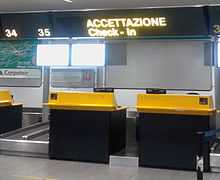
- The acute accent is used over ⟨e⟩ to indicate a stressed front close-mid vowel, as in perché "why, because". In dictionaries, it is also used over ⟨o⟩ to indicate a stressed back close-mid vowel (azióne). The grave accent is used over ⟨e⟩ to indicate a front open-mid vowel, as in tè "tea". The grave accent is used over any vowel to indicate word-final stress, as in gioventù "youth". Unlike ⟨é⟩, a stressed final ⟨o⟩ is always a back open-mid vowel (andrò), making ⟨ó⟩ unnecessary outside of dictionaries. Most of the time, the penultimate syllable is stressed. But if the stressed vowel is the final letter of the word, the accent is mandatory, otherwise it is not (unlike in Spanish) and virtually always omitted. Exceptions are typically either in dictionaries, where all stressed vowels are commonly marked if they are either in a syllable other than the penultimate, or are an e or an o. Alternatively, accents could be included to disambiguate words that differ only by stress, as for prìncipi "princes" and princìpi "principles", or "àncora" "anchor" and "ancòra" "still yet". For monosyllabic words, the rule is different: when two identical monosyllabic words with different meanings exist, the accent is compulsory on one and forbidden on the other (example: è "is", e "and"). Rare, polysyllabic words can have doubtful stress. Istanbul can be accented on the first (Ìstanbul) or second syllable (Istànbul). The U.S. state name Florida is pronounced in Italian as in Spanish with stress on the second syllable (Florìda). Because of an Italian word with the same spelling but different stress (flòrida "flourishing") and because of the English pronunciation, most Italians pronounce Florida with stress on the first syllable. Dictionaries give the latter as an alternative pronunciation.[45]
- The letter ⟨h⟩ distinguishes ho, hai, ha, hanno (present indicative of avere "to have") from o ("or"), ai ("to the"), a ("to"), anno ("year"). In the spoken language, the letter is always silent. The ⟨h⟩ in ho additionally marks the contrasting open pronunciation of the ⟨o⟩. The letter ⟨h⟩ is also used in combinations with other letters. No phoneme [h] exists in Italian. In nativised foreign words, the ⟨h⟩ is silent. For example, hotel and hovercraft are pronounced /oˈtɛl/ and /ˈɔverkraft/ respectively. (Where ⟨h⟩ existed in Latin, it either disappeared or, in a few cases before a back vowel, changed to [ɡ]: traggo "I pull" ← Lat. trahō.)
- The letters ⟨s⟩ and ⟨z⟩ can symbolize voiced or voiceless consonants. ⟨z⟩ symbolizes /dz/ or /ts/ depending on context, with few minimal pairs. For example: zanzara /dzanˈdzaːra/ "mosquito" and nazione /natˈtsjoːne/ "nation". ⟨s⟩ symbolizes /s/ word-initially before a vowel, when clustered with a voiceless consonant (⟨p, f, c, ch⟩), and when doubled; it symbolizes /z/ when between vowels and when clustered with voiced consonants. Intervocalic ⟨s⟩ varies regionally between /s/ and /z/.
- The letters ⟨c⟩ and ⟨g⟩ vary in pronunciation between plosives and affricates depending on following vowels. The letter ⟨c⟩ symbolizes /k/ when word-final and before the back vowels ⟨a, o, u⟩. It symbolizes /tʃ/ as in chair before the front vowels ⟨e, i⟩. The letter ⟨g⟩ symbolizes /ɡ/ when word-final and before the back vowels ⟨a, o, u⟩. It symbolizes /dʒ/ as in gem before the front vowels ⟨e, i⟩. Other Romance languages and, to an extent, English have similar variations for ⟨c, g⟩. Compare hard and soft C, hard and soft G. (See also palatalization.)
- The digraphs ⟨ch⟩ and ⟨gh⟩ indicate or preserve hardness (/k/ and /ɡ/) before ⟨i, e⟩. The digraphs ⟨ci⟩ and ⟨gi⟩ indicate or preserve softness (/tʃ/ and /dʒ/) before ⟨a, o, u⟩. For example:
Before back vowel (A, O, U) Before front vowel (I, E) Plosive C caramella /karaˈmɛlla/ candy CH china /ˈkina/ India ink G gallo /ˈɡallo/ rooster GH ghiro /ˈɡiro/ edible dormouse Affricate CI ciambella /tʃambɛlla/ donut C Cina /ˈtʃina/ China GI giallo /ˈdʒallo/ yellow G giro /ˈdʒiro/ round, tour - Note: ⟨h⟩ is silent in the digraphs ⟨ch⟩, ⟨gh⟩; and ⟨i⟩ is silent in the digraphs ⟨ci⟩ and ⟨gi⟩ before ⟨a, o, u⟩ unless the ⟨i⟩ is stressed. For example, it is silent in ciao /ˈtʃa.o/ and cielo /ˈtʃɛ.lo/, but it is pronounced in farmacia /ˌfar.maˈtʃi.a/ and farmacie /ˌfar.maˈtʃi.e/.
Italian has geminate, or double, consonants, which are distinguished by length and intensity. Length is distinctive for all consonants except for /ʃ/, /dz/, /ʎ/, /ɲ/, which are always geminate, and /z/, which is always single. Geminate plosives and affricates are realised as lengthened closures. Geminate fricatives, nasals, and /l/ are realized as lengthened continuants. There is only one vibrant phoneme /r/ but the actual pronunciation depends on context and regional accent. Generally one can find a flap consonant [ɾ] in unstressed position whereas [r] is more common in stressed syllables, but there may be exceptions. Especially people from the Northern part of Italy (Parma, Aosta Valley, South Tyrol) may pronounce /r/ as [ʀ], [ʁ], or [ʋ].[46]
Of special interest to the linguistic study of Italian is the gorgia toscana, or "Tuscan Throat", the weakening or lenition of certain intervocalic consonants in the Tuscan language.
The voiced postalveolar fricative /ʒ/ is only present in loanwords: for example, garage [ɡaˈraːʒ].
Assimilation
Italian phonotactics do not usually permit verbs and polysyllabic nouns to end with consonants, excepting poetry and song, so foreign words may receive extra terminal vowel sounds.
Grammar
Italian grammar is typical of the grammar of Romance languages in general. It is noteworthy to mention that apart from a similar phonology, Italian is not as similar to Spanish in grammar and vocabulary as many people wrongly believe. Cases exist for pronouns (nominative, oblique, accusative, dative), but not for nouns. There are two genders (masculine and feminine). Nouns, adjectives, and articles inflect for gender and number (singular and plural). Adjectives are sometimes placed before their noun and sometimes after. Subject nouns generally come before the verb. Subjective pronouns are usually dropped, their presence implied by verbal inflections. Noun objects come after the verb, as do pronoun objects after imperative verbs and infinitives, but otherwise pronoun objects come before the verb. There are numerous contractions of prepositions with subsequent articles. There are numerous productive suffixes for diminutive, augmentative, pejorative, attenuating etc., which are also used to create neologisms.
There are three regular sets of verbal conjugations, and various verbs are irregularly conjugated. Within each of these sets of conjugations, there are four simple (one-word) verbal conjugations by person/number in the indicative mood (present tense; past tense with imperfective aspect, past tense with perfective aspect, and future tense), two simple conjugations in the subjunctive mood (present tense and past tense), one simple conjugation in the conditional mood, and one simple conjugation in the imperative mood. Corresponding to each of the simple conjugations, there is a compound conjugation involving a simple conjugation of "to be" or "to have" followed by a past participle. "To have" is used to form compound conjugation when the verb is transitive ("Hai detto", "hai fatto": you have said, you have made), while "to be" is used when the verb is intransitive ("Sei andato", "sei stato": you have gone, you have been). "To be" may be used with transitive verbs, but in such a case it makes the verb passive ("Sei detto", "Sei fatto": you are said, you are made). This rule is not absolute, some exceptions do exist.
Examples
Conversation
| English (inglese) | Italian (italiano) | Pronunciation |
|---|---|---|
| Yes | Sì | (listen) /si/ |
| No | No | (listen) /nɔ/ |
| Of course! | Certo! / Certamente! / Naturalmente! | /ˈt͡ʃɛrto/ /t͡ʃertaˈmente/ /natuɾalˈmente/ |
| Hello! | Ciao! | /ˈt͡ʃao/ |
| Cheers! | Salute! | /saˈlute/ |
| How are you? | Come stai? (informal) / Come sta? (formal) / (Loro) Come stanno? (formal plural) / Come state? (plural) / Come va? (general) | /ˈkomeˈstai/; /ˈkomeˈsta/ /ˈkomestaˈte/ /komevˈva/ |
| Good morning! | Buongiorno! (= Good day!) | /bwɔnˈd͡ʒorno/ |
| Good evening! | Buonasera! | /bwɔnaˈseɾa/ |
| Good night! | Buonanotte! (for a good night sleeping) / Buona serata! (for a good night awake) | /bwɔnaˈnɔtte/ /ˈbwɔna seˈɾata/ |
| Have a nice day! | Buona giornata! (formal) | /bwɔna d͡ʒorˈnata/ |
| Enjoy the meal! | Buon appetito! | /bwɔn‿appeˈtito/ |
| Goodbye! | Arrivederci (general) / Arrivederla (formal) / Ciao! (informal) | (listen) /arriveˈdert͡ʃi/ |
| Good luck! | Buona fortuna! (general) | /bwɔna forˈtuna/ |
| I love you | Ti amo (between lovers only) / Ti voglio bene (in the sense of "I am fond of you", between lovers, friends, relatives etc.) | /ti ˈvɔʎʎo ˈbɛne/; /ti ˈamo/ |
| Welcome [to...] | Benvenuto/-i (for male/males or mixed) / Benvenuta/-e (for female/females) [a / in...] | /beɱveˈnuto/ |
| Please | Per favore / Per piacere / Per cortesia | (listen) /per faˈvoɾe/ /per pjaˈt͡ʃeɾe/ /per korteˈzia/ |
| Thank you! | Grazie! (general) / Ti ringrazio! (informal) / La ringrazio! (formal) / Vi ringrazio! (plural) | (listen) /ˈɡratt͡sje/ /ti riŋˈgratt͡sjo/ |
| You are welcome! | Prego! | /ˈprɛɡo/ |
| Excuse me / I am sorry | Mi dispiace (only "I am sorry") / Scusa(mi) (informal) / Mi scusi (formal) / Scusatemi (plural) / Sono desolato ("I am sorry", if male) / Sono desolata ("I am sorry", if female) | (listen) /ˈskuzi/; /ˈskuza/; /mi disˈpjat͡ʃe/ |
| Who? | Chi? | /ki/ |
| What? | Che cosa? / Cosa? / Che? | /ke ˈkɔza/ /ˈkɔza/ /ke/ |
| When? | Quando? | /ˈkwando/ |
| Where? | Dove? | /ˈdove/ |
| How? | Come? | /ˈkome/ |
| Why / Because | perché | /perˈke/ |
| Again | di nuovo / ancora | /di ˈnwɔvo/; /aŋˈkora/ |
| How much? / How many? | Quanto? / Quanta? / Quanti? / Quante? | /ˈkwanto/ |
| What is your name? | Come ti chiami? (informal) / Qual è il suo nome? (formal) / Come si chiama? (formal) | /ˈkome ti ˈkjami/ /kwaˈlɛ il ˈsuo ˈnome/ |
| My name is ... | Mi chiamo ... | /mi ˈkjamo/ |
| This is ... | Questo è ... (masculine) / Questa è ... (feminine) | /ˈkwesto ɛ/ /ˈkwesta ɛ/ |
| Yes, I understand. | Sì, capisco. / Ho capito. | /si kaˈpisko/ /ɔ kaˈpito/ |
| I do not understand. | Non capisco. / Non ho capito. | (listen) /noŋ kaˈpisko/ /non‿ɔ kaˈpito/ |
| Do you speak English? | Parli inglese? (informal) / Parla inglese? (formal) / Parlate inglese? (plural) | (listen) /parˈlate iŋˈɡleze/ |
| I do not understand Italian. | Non capisco l'italiano. | /noŋ kaˈpisko litaˈljano/ |
| Help me! | Aiutami! (informal) / Mi aiuti! (formal) / Aiutatemi! (plural) / Aiuto! (general) | /aˈjutami/ /ajuˈtatemi/ /aˈjuto/ |
| You are right/wrong! | (Tu) hai ragione/torto! (informal) / (Lei) ha ragione/torto! (formal) / (Voi) avete ragione/torto! (plural) | |
| What time is it? | Che ora è? / Che ore sono? | /ke oɾa ɛ/ /ke ˈoɾe ˈsono/ |
| Where is the bathroom? | Dov'è il bagno? | (listen) /doˈvɛ (i)l baɲɲo/ |
| How much is it? | Quanto costa? | /ˈkwanto ˈkɔsta/ |
| The bill, please. | Il conto, per favore. | /il ˈkonto per faˈvoɾe/ |
| The study of Italian sharpens the mind. | Lo studio dell'italiano aguzza l'ingegno. | /loˈstudjo dellitaˈljano aˈgutt͡sa linˈd͡ʒeɲɲo/ |
Numbers
|
|
|
| English | Italian | IPA |
|---|---|---|
| one hundred | cento | /ˈt͡ʃɛnto/ |
| one thousand | mille | /ˈmille/ |
| two thousand | duemila | /ˌdueˈmila/ |
| two thousand thirteen {2013} | duemilatredici | /dueˌmilaˈtredit͡ʃi/ |
Days of the week
| English | Italian | IPA |
|---|---|---|
| Monday | lunedì | /luneˈdi/ |
| Tuesday | martedì | /marteˈdi/ |
| Wednesday | mercoledì | /merkoleˈdi/ |
| Thursday | giovedì | /dʒoveˈdi/ |
| Friday | venerdì | /venerˈdi/ |
| Saturday | sabato | /ˈsabato/ |
| Sunday | domenica | /doˈmenika/ |
Sample texts
There is a recording of Dante's Divine Comedy read by Lino Pertile available at http://etcweb.princeton.edu/dante/pdp/
See also
| Italian edition of Wikipedia, the free encyclopedia |
- Languages of Italy
- Accademia della Crusca
- CELI
- CILS (Qualification)
- Enciclopedia Italiana
- Guide to phonetic transliteration of Italian
- Italian alphabet
- Italian dialects
- Italian exonyms
- Italian grammar
- Italian honorifics
- The Italian Language Foundation (in the United States)
- Italian language in Slovenia
- Italian literature
- Italian musical terms
- Italian phonology
- Italian profanity
- Italian Sign Language
- Italian Studies
- Italian Wikipedia
- Italian-language international radio stations
- List of languages of Italy
- Lessico etimologico italiano
- Sicilian School
- Veronese Riddle
- Languages of the Vatican City
- Talian
References and notes
- ↑ Italian at Ethnologue (18th ed., 2015)
- ↑ CDI: italiano segnato
- ↑ CDI: italiano segnato esatto
- ↑ Nordhoff, Sebastian; Hammarström, Harald; Forkel, Robert; Haspelmath, Martin, eds. (2013). "Italian". Glottolog. Leipzig: Max Planck Institute for Evolutionary Anthropology.
- ↑ 5.0 5.1 5.2 5.3 Ethnologue report for language code:ita (Italy) – Gordon, Raymond G., Jr. (ed.), 2005. Ethnologue: Languages of the World, Fifteenth edition. Dallas, Tex.: SIL International. Online version
- ↑ Languages of Italy – Ethnologue – Languages of the World – Copyright 2010 SIL International.
- ↑ 7.0 7.1 Eurobarometer – Europeans and their languages PDF (485 KB), February 2006
- ↑ Italian language University of Leicester
- ↑
- ↑ Legge sulle fonti del diritto of 7 June 1929, laws and regulations are published in the Italian-language Supplemento per le leggi e disposizioni dello Stato della Città del Vaticano attached to the Acta Apostolicae Sedis.
- ↑ Modern Italian The Italian Language Retrieved 2010-05-16
- ↑ 12.0 12.1 Grimes, Barbara F. (October 1996). Barbara F. Grimes, ed. Ethnologue: Languages of the World. Consulting Editors: Richard S. Pittman & Joseph E. Grimes (thirteenth ed.). Dallas, Texas: Summer Institute of Linguistics, Academic Pub. ISBN 1-55671-026-7.
- ↑ "History of the Italian language.". Retrieved 2006-09-24.
- ↑ "Lewis, M. Paul (ed.), 2009. Ethnologue: Languages of the World, Sixteenth edition". Ethnologue.com. Retrieved 2010-04-21.
- ↑ Brincat (2005)
- ↑ Lüdi, Georges; Werlen, Iwar (April 2005). "Recensement Fédéral de la Population 2000 — Le Paysage Linguistique en Suisse" (PDF) (in French, German, and Italian). Neuchâtel: Office fédéral de la statistique. Retrieved 5 January 2006.
- ↑ The Vatican City State appendix to the Acta Apostolicae Sedis is entirely in Italian.
- ↑ "Europeans and their Languages" (PDF). Europeans and their Languages. European Commission: Directorate General for Education and Culture and Directorate General Press and Communication. February 2006. Retrieved 28 June 2013.
- ↑ "Society". Monaco-IQ Business Intelligence. Lydia Porter. 2007–2013. Retrieved 28 June 2013.
- ↑ "France". Ethnologue. SIL International. 2013. Retrieved 28 June 2013.
- ↑ www.iht: news/Italy
- ↑ "Scuola Italiana di Asmara (in Italian)". Scuoleasmara.it. Retrieved 2010-04-21.
- ↑ Diana Briton Putman, Mohamood Cabdi Noor, The Somalis: their history and culture, (Center for Applied Linguistics: 1993), p. 15.: "Somalis speak Somali. Many people also speak Arabic, and educated Somalis usually speak English. Swahili may also be spoken in coastal areas near Kenya."
- ↑ "Language Spoken at Home: 2000". United States Bureau of the Census. Retrieved 8 August 2012.
- ↑ Capricorn Agency, http://netcapricorn.com/newsletter/italian_ethnic_market.html
- ↑ "Statistics Canada 2006". 2.statcan.ca. 8 April 2010. Retrieved 2010-04-21.
- ↑ http://www.censusdata.abs.gov.au/census_services/getproduct/census/2011/quickstat/0
- ↑ http://www.lastampa.it/2014/07/02/italia/cronache/lingua-italiana-la-quarta-pi-studiata-nel-mondo-NdOvjvS27hybRegFLXyl3H/pagina.html
- ↑ "9". Iic-colonia.de. Retrieved 2010-04-21.
- ↑ 30.0 30.1 Dati del Ministero degli Affari Esteri
- ↑ Language-learning trends in the United States VistaWide Retrieved 2010-05-16
- ↑ "www.iic-colonia.de". www.iic-colonia.de. Retrieved 2010-04-21.
- ↑ "Eurobarometer pool (2006), page 152" (PDF). Retrieved 2 June 2012.
- ↑ A language of Italy Ethnologue Retrieved 2010-06-05
- ↑ Longo, Maurizio (2007). "La lingua italiana in Albania" (PDF). Education et Sociétés Plurilingues (in Italian) (22): 51–56. Retrieved 28 July 2014.
Today, even though for political reasons English is the most widely taught foreign language in Albanian schools, Italian is anyway the most widespread foreign language.
- ↑ Longo, Maurizio; Ademi, Esmeralda; Bulija, Mirjana (June 2010). "Una quantificazione della penetrazione della lingua italiana in Albania tramite la televisione (III)" [A quantification of the diffusion of the Italian language in Albania via television] (PDF). Education et Sociétés Plurilingues (in Italian) (28): 53–63. Retrieved 28 July 2014.
- ↑ "Major Dialects of Italian".
- ↑ Hall (1944:77–78)
- ↑ Hall (1944:78)
- ↑ Rogers & d'Arcangeli (2004:117)
- ↑ Bertinetto & Loporcaro (2005:132)
- ↑ Luciano Canepari, A Handbook of Pronunciation, chapter 3: «Italian».
- ↑ http://www.dizionario.rai.it/poplemma.aspx?lid=30356&r=69940
- ↑ http://www.dizionario.rai.it/poplemma.aspx?lid=30351&r=13567
- ↑ (Italian) Dizionario d'ortografia e di pronunzia
- ↑ Canepari, Luciano (January 1999). Il MªPI – Manuale di pronuncia italiana (second ed.). Bologna: Zanichelli. ISBN 88-08-24624-8.
Bibliography
- Rogers, Derek; d'Arcangeli, Luciana (2004). "Italian". Journal of the International Phonetic Association 34 (1): 117–121. doi:10.1017/S0025100304001628.
- M. Vitale, Studi di Storia della Lingua Italiana, LED Edizioni Universitarie, Milano, 1992, ISBN 88-7916-015-X
- S. Morgana, Capitoli di Storia Linguistica Italiana, LED Edizioni Universitarie, Milano, 2003, ISBN 88-7916-211-X
- J. Kinder, CLIC: Cultura e Lingua d'Italia in CD-ROM / Culture and Language of Italy on CD-ROM, Interlinea, Novara, 2008, ISBN 978-88-8212-637-7
External links
| Italian edition of Wikipedia, the free encyclopedia |
| Italian edition of Wikisource, the free library |
| Wikiversity has learning materials about Italian |
| Wikivoyage has a phrasebook for Italian. |
| Look up Italian in Wiktionary, the free dictionary. |
| Look up Category:Italian language in Wiktionary, the free dictionary. |
| Wikibooks has a book on the topic of: Italian |
| Wikimedia Commons has media related to Italian language. |
- Swadesh list in English and Italian
- Italian proverbs
- Learn Italian – Molto Bene
- "Learn Italian," BBC
- Online English-Italian Translation
- USA Foreign Service Institute Italian basic course
- Map of speaking Italian communities in the world, italofonia.org (Italian)
| ||||||||||||||||||||||||||||||||||||||||||||||||||||||||||||||||||||||||||||||||||||||||||||||||||||||||||||
| ||||||||||
